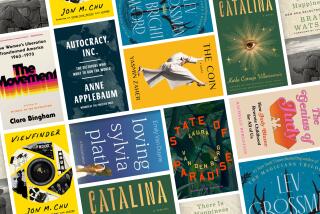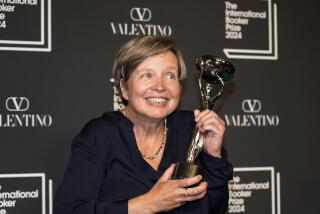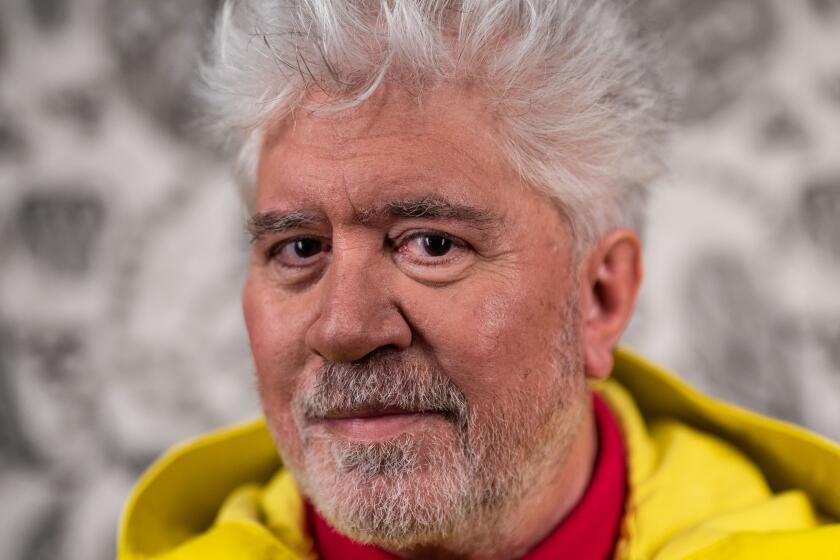John Freeman, at Skylight Tuesday, on ‘How to Read a Novelist’
On his book tour, the tables have been turning on John Freeman: A parade of luminous authors are interviewing him. He’s already sat down for public conversations with Teju Cole, Geoff Dyer, Aleksandar Hemon, and Marilynne Robinson, and on Tuesday night, it’ll be Mark Z. Danielewski. That’s at Skylight Books in Los Feliz at 7:30 p.m.
Freeman’s new book, “How to Read a Novelist,” compiles his interviews with and profiles of 55 authors. It includes seven Nobel Laureates -- Toni Morrison, Gunter Grass, Nadine Gordimer, Doris Lessing, Imre Kertesz, Mo Yan, and Orhan Pamuk. There are bestselling authors (John Irving, Tom Wolfe), Man Booker Prize winners (including Salman Rushdie, Peter Carey, Ian McEwan), National Book Award winners (Philip Roth, Charles Frazier, Don Delillo, Jonathan Franzen, William T. Vollman and more), and Pulitzer prize-winners (including Marilynne Robinson, Jennifer Egan), as well as authors who are not well known, like Hisham Matar and Ayu Utami.
Freeman recently left his post as editor of Granta, where he was a tireless advocate for great literature from across the globe. “How to Read a Novelist,” his second book, includes interviews dating back 15 years, when he was a widely published book critic and president of the National Book Critics Circle. he answered my questions about “How to Read a Novelist” by email.
You’ll be talking to Mark Z. Danielewski at Skylight. Where did your piece on him appear, and was it one of the earlier stories to capture the scope and ambition of “House of Leaves”? Do stories like that affect your relationship with writers?
The piece on Danielewski appeared in TimeOut New York and it was, I think, his first interview. I don’t think I got all the book’s complexity, you’d need a dissertation for that, but I put the profile in the book because I did feel on rereading it that the sense of Mark being on the precipice of something great was there, and he was. I’m rereading the book right now, as I am teaching it in a writing class at Columbia University, and the narrative complexity and heart it shows is just extraordinary. It’ll be a classic. And I feel lucky to have been one if its early readers, which is what you are as an interviewer. You have an immense amount of power in that; you can squash something great very easily if the venue is big enough. So it forces the writer, if they agree to these things, into a position of trust that can lend itself an incredible intimacy. It can make it hard to review their work later, but that’s the breaks.
There are 55 author profiles in “How to Read a Novelist,” and they’re not organized in an obvious way, alphabetically or chronologically -- can you talk about their order, the arc of the book?
I thought about this a lot at Granta, how to create an arc, or at least a pleasing progression, from disparate material. I always tried to put the piece with the deepest, widest arrays of notes first, and a big noisy conclusion at the end, with an order within that never jarred, or at least so I hope. It’s a bit like music. Here, with this book, I started with [Toni] Morrison for all these reasons. Her story, of starting out from a little town in Ohio, of writing the great books she has by wrestling with Faulkner and America’s complex and often shameful past, was and is still inspiring to me. She did this work by rising at 4 and writing before daybreak, upon which point she had to get her kids ready for school, after which she would spend all day as an editor championing books by black writers who had been overlooked. For me, her life and her work define essential writing: writing that only that author can do, which they have to do, and which becomes essential to knowing what it means to be human. I ended with Jennifer Egan because her work is my most recent passion. Also, the thing Morrison talks about in our interview, what she calls deep structure, I found excitingly updated and carried into the 21st century in Egan’s work, especially that recent story “Black Box.”
You spoke to some writers -- Jeffrey Eugenides, Jonathan Franzen -- in their homes. Others you catch on book tour (Gunter Grass in his hotel room). When talking to an author, what effect does it have on the interview to catch them in transit versus their natural habitat?
Obviously the home is best, because you get to look at their stuff, as Julian Barnes once put it. Sometimes, though, the transient scene winds up being very apt, as with, say, Robert M. Pirsig [Author of “Zen and the Art of Motorcycle Maintenance”], who I interviewed at a hotel on the Charles River. It was his first interview in almost 20 years, and we were talking about “Lila,” his second book, which takes place on a river. The room was spartan, too, and he had laid down a tatami mat so we could chat. In the end it felt perfect, like an unlikely Zen temple, where we sat and discussed ideas.
You’ve been a prolific book critic and president of the National Book Critics Circle. What’s the difference between a book critic and a literary interviewer?
As a critic you have two points of duty: to the book, as in faithfully representing what it sets out to do and whether the book achieves that, and to the audience, who need to know whether they should read the thing. As an interviewer, however, you have three fealties to honor; to the work; to the audience; and to the person you’re writing about. I love doing both types of writing, the reviewing because one is laying an argument, and trying, as best you can, to make a reader feel when they’ve reached the end that your conclusions are their conclusions. The best way to do that, I believe, is to try to re-create the experience of reading a book. To capture what it feels like to be in it. I believe that a profile can be criticism too, though, because through a bit of literary origami, the idea is you can simultaneously get across to the reader what it’s like to meet a subject and be inside their work, capture the spooky disjunctures of that experience, its surprising (or not so surprising) points of overlap.
In some instances, like when you talk to Don Delillo, you’re speaking to a great author on the occasion of a lesser work. What do you think readers can learn from that interchange? Is there something different there that might not surface in an interview about “Libra”?
I think it’s often more exciting to see writers during books that get less attention, especially, as in DeLillo’s case, when it’s work which captures the writer dreaming in a different language. There are so many phases to DeLillo’s work, from the observatory brilliance of the first decade, in books like “Americana” and “Great Jones Street,” to the meditations on structure and codes embedded in “The Names” and “White Noise,” to all those novels about history like “Libra” and “Underworld” and “Falling Man,” to these late books about the emptying of language and the body. His plays, to me, return his work to its primal concerns and also join it together. They are, to me, like those touchingly delicate-looking struts on modern bridges that manage to keep the whole thing up.
Your book “How to Read a Novelist” seems in some ways to be in dialogue with James Woods’ “How Fiction Works.” Have you read it? How do these books continue the conversation readers have with fiction?
I have! That’s when I sat down with him, and it was odd to read a book and enjoy it so much -- he is such a fine writer, the way he deploys metaphor and writes on the level of the novelists he critiques -- and yet I disagreed with one of the book’s central assumptions, which is that free indirect style, if I understand his argument, is if not the pinnacle, than certainly a dominant mode of narration of the novel. He lays out its uses so elegantly in that book, I almost, but didn’t forget about all the writers to whom it doesn’t apply; namely, Faulkner, Morrison, Erdrich, Diaz, and Carey, who are way up there among my favorites in terms of recent novelists. Actually, many of the writers in my book when I think about it. I often have students of his in my class at Columbia and I find I am possibly scrambling their ideas by contradicting what he says in his lectures. I hope not. Anyway, perhaps one day we will debate it out, in a ring, filled with motor oil.
In your preface, you write about the unfortunate events around idolizing John Updike and also interviewing him. Now, as a more seasoned author, you’ve become friends with some of your subjects. Do you think this a typical path, from fan to insider?
No it’s quite rare, I know, and yet no matter how it looks from the outside, I still feel like an outsider on the inside, in my head, which lives somewhere east of Sacramento, where I grew up, and west of Cleveland, where I was born. There are writers who are my friends now, but it’s always become a friendship for reasons additional to admiration, for loyalty and love and trust and humor. Which is too much to ask from even the best interview.
At some point, will you be done with writing about authors? Is there anyone you’d still like to interview?
No way! Every year there are new writers whose work I fall in love with, like NoViolet Bulawayo and Chinelo Okpatanta this year, and others who I’ve missed for scheduling reasons, perhaps, like Aminatta Forna, who is a fierce storyteller, or Herta Muller, who is one of the greatest Nobel winners ever in my book. I once had tea and cakes with Kenzaburo Oe and forgot to turn my tape recorder on, so I still hope to talk to him, officially, as well as Eleanor Catton, Yasar Kemal and Joy Williams. I could go on, and I hope, I will.
ALSO:
Ronan Farrow: Our next public intellectual
What does Alan Greenspan have in common with Michel Houellebecq?
‘Breakfast With Lucian’ presents an eye-popping portrait of Freud, the painter
Carolyn Kellogg: Join me on Twitter, Facebook and Google+
More to Read
Sign up for our Book Club newsletter
Get the latest news, events and more from the Los Angeles Times Book Club, and help us get L.A. reading and talking.
You may occasionally receive promotional content from the Los Angeles Times.









